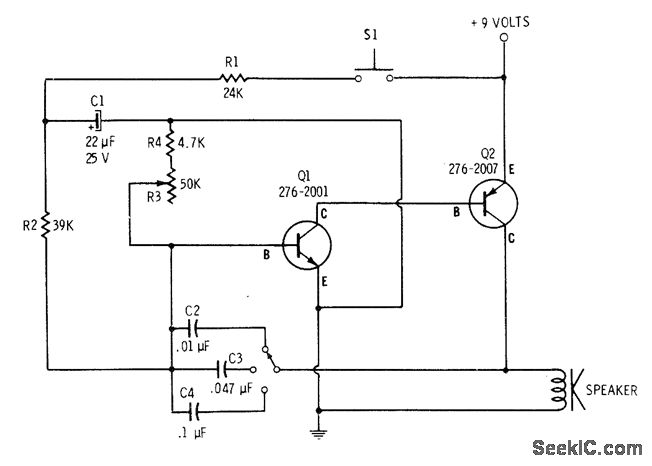
One-IC two-tones Siren

One integrated circuit (IC) two-tone siren. It produces a double-tone police sound and a single-tone old ambulance sound. Circuit diagram components include R1 and R3, which are 470K ohm 1/4 watt resistors, and R2, which is a 680K ohm 1/4 watt resistor.
The circuit is designed to generate two distinct audio tones that can be used for signaling purposes, such as in emergency vehicles. The primary component of this circuit is an integrated circuit that is capable of producing sound frequencies corresponding to the specified tones.
The two-tone police sound is typically characterized by alternating frequencies, creating a distinctive alert that is easily recognizable. In contrast, the single-tone ambulance sound provides a continuous tone that can be used in situations where a single alert is sufficient.
The resistors play a crucial role in determining the frequency of the oscillations produced by the circuit. Resistors R1 and R3, each rated at 470K ohms, are used in conjunction with R2, which is rated at 680K ohms, to set the timing intervals for the oscillation. The values of these resistors can be adjusted to modify the pitch and duration of the tones generated by the circuit, allowing for customization based on specific requirements.
In practical applications, this siren circuit can be powered by a standard DC power supply, and it may include additional components such as capacitors for filtering and smoothing the output signal. The output of the circuit can be connected to a speaker or a piezo buzzer to produce audible sound. Proper layout and connections in the circuit diagram are essential to ensure optimal performance and reliability of the siren tones.
Overall, this circuit serves as a versatile and effective solution for generating emergency alert sounds in various applications, including police cars, ambulances, and other emergency response vehicles.One-IC two-tones Siren. Double-tone Police sound. Single-tone old ambulance sound. Circuit diagram: Parts: R1,R3 470K 1/4W Resistors R2 680K 1/4W. 🔗 External reference
The circuit is designed to generate two distinct audio tones that can be used for signaling purposes, such as in emergency vehicles. The primary component of this circuit is an integrated circuit that is capable of producing sound frequencies corresponding to the specified tones.
The two-tone police sound is typically characterized by alternating frequencies, creating a distinctive alert that is easily recognizable. In contrast, the single-tone ambulance sound provides a continuous tone that can be used in situations where a single alert is sufficient.
The resistors play a crucial role in determining the frequency of the oscillations produced by the circuit. Resistors R1 and R3, each rated at 470K ohms, are used in conjunction with R2, which is rated at 680K ohms, to set the timing intervals for the oscillation. The values of these resistors can be adjusted to modify the pitch and duration of the tones generated by the circuit, allowing for customization based on specific requirements.
In practical applications, this siren circuit can be powered by a standard DC power supply, and it may include additional components such as capacitors for filtering and smoothing the output signal. The output of the circuit can be connected to a speaker or a piezo buzzer to produce audible sound. Proper layout and connections in the circuit diagram are essential to ensure optimal performance and reliability of the siren tones.
Overall, this circuit serves as a versatile and effective solution for generating emergency alert sounds in various applications, including police cars, ambulances, and other emergency response vehicles.One-IC two-tones Siren. Double-tone Police sound. Single-tone old ambulance sound. Circuit diagram: Parts: R1,R3 470K 1/4W Resistors R2 680K 1/4W. 🔗 External reference





